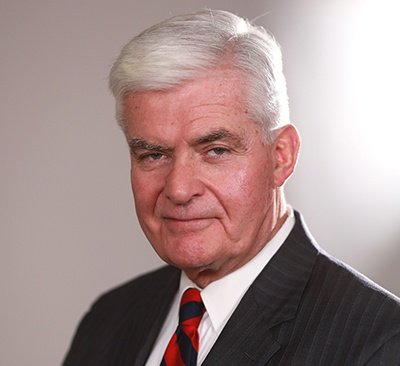At any reverse mortgage industry conference, the name “George Downey” brings a smile to the faces of the industry professionals who hear it. A longtime member of the National Reverse Mortgage Lenders Association (NRMLA) board of directors, Downey has been instrumental in working with legislators to create more opportunity for reverse mortgage professionals to operate within his home state of Massachusetts.
Downey was recently recognized for his efforts on behalf of the industry with a distinguished service award from NRMLA. The award was presented to his son on his behalf at NRMLA’s annual meeting and expo last month.
In the latest edition of RMD’s “Origins” feature series, Downey discusses his path into the reverse mortgage business and offers advice for those who want longevity in the industry.
Downey’s start in the industry
Downey’s career began in financial services at Merrill Lynch, which then led to a role at a money management firm. His pivot to a reverse mortgage career did not come into full view until much later, however.
“When I started our company Harbor Mortgage Solutions in 1991, we were providing traditional forward mortgage services,” Downey said. “We didn’t become aware of reverse mortgages until really 2000 or 2001. And as we became aware of it, and then understood what the product did and the cohort that it served, we were able to connect the dots and really recognize the product’s potential for financial and retirement planning. So that’s what got us into it.”

When asked what the catalyst was to pique his interest in reverse mortgages, Downey credited a call from a colleague while working in forward mortgage as the turning point.
“We, like everybody else, thought that reverse mortgages were created by the devil himself and that they were the last resort that [a senior] should consider,” Downey said. “We had a call from a colleague on the island of Nantucket who had a dear friend who had a reverse mortgage that was being foreclosed.”
That call caused Downey and his associates to take a closer look at the reverse mortgage product.
The colleague’s friend, whose existing private-label reverse mortgage was on valuable waterfront property, had the lender trying to gain access to the property through the foreclosure process.
Downey’s plan initially was to have the borrower pay the private reverse mortgage balance in full using more traditional financing, such as a forward mortgage or a home equity line of credit.
“Unfortunately, the property owner was a woman in her late 80s who did not have the financial resources and could not qualify for any traditional financing,” Downey said. “So we were unable to do that financing to pay off that reverse mortgage.”
A journey into reverse
Since the homeowner did not qualify for traditional financing, Downey and his team looked at less conventional options, including the specifics of a reverse mortgage.
“As we looked into it, [we realized that] the solution was to do a reverse mortgage to refinance the private reverse mortgage they had,” Downey said. “So that’s what got us started into it.”
The homeowner started the origination process for a refinance with Financial Freedom, but ultimately passed away before the transaction was complete. While that curbed the need to assist his colleague, the situation led to a new beginning for Downey and Harbor Mortgage Solutions.
“Actually, within trying to defeat the reverse mortgage that she had, [we found] out that it enabled us to acquire a deeper understanding of the attributes of the program itself,” Downey said. “So that was our introduction.”
The key to business longevity
Downey has seen significant products changes handed down federally and shifts in the companies that are active players during his 20-plus years in the reverse mortgage industry. And, while there have been difficulties related to regulatory decisions, Downey said, the product is better as a result.
“I think that the net effect of the changes has been constructive and positive,” he said. “It’s made for a better product than it was in its earlier times. Unquestionably, some of the changes that have taken place created setbacks, including PLF changes and the elimination of the floor. These have made [the business] more challenging. But on balance, I think that the changes have been very constructive, and made the program a better, more secure program for consumers.”
Many companies have come and gone from the reverse mortgage space over the course of Downey’s career. When it comes to Downey’s longevity in the business, he said his success boils down to two house rules for his company.
“House rule number one is [to] do the right thing for each client every time,’” Downey said. “And rule number two is ‘don’t forget rule number one.’”
Because the reverse mortgage product serves a protected class, and many seniors have a limited understanding of how it may help them, Downey said the key is to help a client determine whether it’s the right move to make.
“It’s a wonderful product for the right situation,” Downey said. “And if the situation is not right, they shouldn’t do it. And it’s up to us to be really the beacons there and to guide them to that.”





